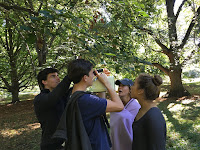BB&N MS Guerrilla Artists Meet Public Art in Cambridge
Sasha Bergmann, Middle School Art Teacher
Sasha Bergmann, Middle School Art Teacher
Urban Connections Grant
Fall 2016
Save the Turtles
We hope our sculpture brings awareness to our unconscious overuse of plastic and how it harms the sea animals… and humans.
Artists: Ellie Berman, Tali Beckhardt, Zoe Berman,
Naomi Wang, Claire Sun Woo Chu, Emma Worthington
(Facilitator: Ms. Bergmann)
Hundreds of thousands of sea turtles, whales, and other marine mammals, and more than 1 million seabirds die each year from ocean pollution and ingestion or entanglement in marine debris. Marine debris is manmade waste that is directly or indirectly disposed of in oceans, rivers, and other waterways. http://www.seeturtles.org/ocean-plastic/
Additionally, ... plastics take thousands of years to decay. As a result, fish and wildlife are becoming intoxicated. Consequently the toxins from the plastics have entered the food chain, threatening human health.
Beginning with Ideas:
We collected Plastic
from our Middle School Community:
Building the Sea Turtle together:
Juxtapose Life & Death by
Planting Seeds on Top of the Turtle:
Installation of the Project:
The Turtle is Installed under the Deck of the Arts Building at BB&N Middle School.
Our Final Project:

























